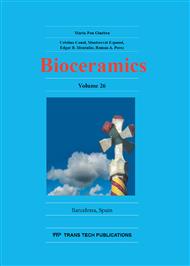[1]
P.B. White, A.S. Ranawat, C.S. Ranawat. Ceramic-on-polyethylene: The experience of the Ranawat Orthopaedic Center. Sem. Arthr. 2013; 24: 206-210.
DOI: 10.1053/j.sart.2014.01.006
Google Scholar
[2]
J.R. Jeffers, W.L. Walter. Ceramic-on-ceramic bearings in hip arthroplasty: state of the art and the future. J. Bone Joint Surg. Br. 2012; 94: 735-745.
DOI: 10.1302/0301-620x.94b6.28801
Google Scholar
[3]
O. Roualdes, M. -E. Duclos, D. Gutknecht, L. Frappart, J. Chevalier, In vitro and in vivo evaluation of an alumina-zirconia composite for arthroplasty applications. Biomat. 2010; 2043-(2054).
DOI: 10.1016/j.biomaterials.2009.11.107
Google Scholar
[4]
S.M. Kurtz, S.B. Kocagöz, J.A. Hanzlik, R.J. Underwood, J.L. Gilbert, D.W. MacDonald, G. -C. Lee, M.A. Mont, M.J. Kraay, G.R. Klein, J. Parvizi, C.M. Rimnac. Do ceramic femoral heads reduce taper fretting corrosion in hip arthroplasty? A retrieval study. Clin. Orthop. Relat. Res. 2013; 471: 3270-3282.
DOI: 10.1007/s11999-013-3096-2
Google Scholar
[5]
W.L. Walter, G.M. Insley W.K. Walter, M.A. Tuke. Edge loading in third generation alumina ceramic-on-ceramic bearings: stripe wear. J. Arthr. 2004; 19: 402-413.
DOI: 10.1016/j.arth.2003.09.018
Google Scholar
[6]
J. -M. Brandt, T.C. Gascoyne, L.E. Guenther, A. Allen, D.R. Hedden, T.R. Turgeon and E. R. Bohm. Clinical failure analysis of contemporary ceramic-on-ceramic total hip replacements. Proc. I. Mech. E Part H: J. Eng. Med. 2013; 227: 833–846.
DOI: 10.1177/0954411913489803
Google Scholar
[7]
Y-M. Kwon, S.J. Mellon, P. Monk, D.W. Murray, H.S. Gill. In vivo evaluation of edge-loading in metal-on-metal hip resurfacing patients with pseudotumors. Bone Joint Res. 2012; 1: 42-49.
DOI: 10.1302/2046-3758.14.2000019
Google Scholar
[8]
H. Tribe, S. Malek, J. Stammers, V. Ranawat, J.A. Skinner. Advanced wear of an Oxinium™ femoral head implant following polyethylene liner dislocation. Ann. R. Coll. Surg. Engl. 2013; 95: 133-135.
DOI: 10.1308/003588413x13629960047876
Google Scholar
[9]
V. Good, M. Ries, R.L. Barrack, K. Widding, G. Hunter, D. Heuer. Reduced wear with oxidized zirconium femoral heads. J. Bone Joint Surg. (Am) 2003; 85: 105-110.
DOI: 10.2106/00004623-200300004-00013
Google Scholar
[10]
G.T. Evangelista, E. Fulkerson, F. Kummer, P.E. Di Cesare. Surface damage to an Oxinium femoral head prosthesis after dislocation. J. Bone Joint Surg. (Br) 2007; 89: 535-537.
DOI: 10.1302/0301-620x.89b4.17557
Google Scholar
[11]
Gibon E, Scemama C, David B, Hamadouche M. Oxinium femoral head damage generated by a metallic foreign body within polyethylene cup following recurrent dislocation episodes. Orthop Trauma Surg Res 2013; 99: 865-69.
DOI: 10.1016/j.otsr.2013.04.011
Google Scholar
[12]
Kim YH, Park JW, Kim JS. Comparison of the Genesis II total knee replacement with oxidised zirconium and cobalt-chromium femoral components in the same patients. Journal of Bone & Joint Surgery, British Volume 2012; 94-B: 1221-7.
DOI: 10.1302/0301-620x.94b9.28854
Google Scholar
[13]
McCalden RW, Charron KD, Davidson RD, Teeter MG, Holdsworth DW. Damage of an Oxinium femeral head and polyethylene liner following routine total hip replacement. J Bone Joint Surg (Br) 2011; 93-B: 409-13.
DOI: 10.1302/0301-620x.93b3.25327
Google Scholar
[14]
Kadar T, Hallan G, Aamodt A, et al. Wear and migration of highly cross-linked and conventional cemented polyethylene cups with cobalt chrome or Oxinium femoral heads: A randomized radiostereometric study of 150 patients. J Orthop Res 2011; 29(8): 1222-29.
DOI: 10.1002/jor.21389
Google Scholar
[15]
Halim T, Burgett M, Donaldson TK, Savisaar C, Bowsher J, Clarke IC. Profiling the third-body damage produced in CoCr surfaces by bone cement, CoCr and Ti6Al4V debris: A 10-cycle metal-on-metal simulator test. Proc Inst Mech Eng, Part H: J Eng Med. 2014, Published online, doi: 10. 1177/0954411914538782.
DOI: 10.1177/0954411914538782
Google Scholar
[16]
M.C. Galetz, E.W. Fleischmann, C.H. Konrad, A. Schuetz, U. Glatzel. Abrasion resistance of oxidized zirconium in comparison with CoCrMo and Titanium nitride coatings for artificial knee joints. J Biomed Mater Res Part B: Appl Biomater 2010; 93B: 244-51.
DOI: 10.1002/jbm.b.31581
Google Scholar
[17]
EN 1071-3: 2005. Advanced technical ceramics - Methods of test for ceramic coatings - Part 3: Determination of adhesion and other mechanical failure modes by a scratch test.
DOI: 10.3403/30078580u
Google Scholar


